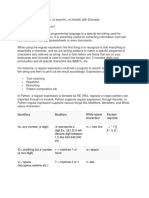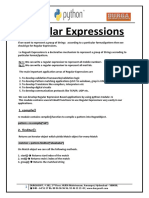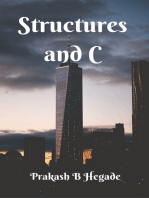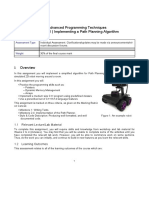0 ratings0% found this document useful (0 votes)
20 viewsIntroduction To Regular Expressions in Python - Transcript
The document discusses regular expressions in Python. It covers importing the re module, constructing patterns using meta characters like caret and dollar sign, and using functions like search to match patterns in strings. Qualifiers like question mark, plus, and asterisk are also explained. Ranges with hyphen and matching single characters with dot are discussed. The overall goal is to learn how to validate passwords and user input with regex.
Uploaded by
Diana Carolina Mayorga RamirezCopyright
© © All Rights Reserved
Available Formats
Download as TXT, PDF, TXT or read online on Scribd
0 ratings0% found this document useful (0 votes)
20 viewsIntroduction To Regular Expressions in Python - Transcript
The document discusses regular expressions in Python. It covers importing the re module, constructing patterns using meta characters like caret and dollar sign, and using functions like search to match patterns in strings. Qualifiers like question mark, plus, and asterisk are also explained. Ranges with hyphen and matching single characters with dot are discussed. The overall goal is to learn how to validate passwords and user input with regex.
Uploaded by
Diana Carolina Mayorga RamirezCopyright
© © All Rights Reserved
Available Formats
Download as TXT, PDF, TXT or read online on Scribd
You are on page 1/ 4
Welcome to this project.
Regular expressions in python.
So in this project we're going to learn how to construct,
regulates patterns validate passwords and user input in wet
forms and extract patterns, replace strings with rejects.
So a red X.
Or regular expression or pattern is a concatenation
of letters, numbers or symbols to search stuff.
I would say within a larger text, a text that we want to scan.
So working with regular expressions in python usually
requires three steps.
First you import a module called R E in python.
Then you construct the pattern with various symbols
and characters.
And then third you use the ari function to search, replace
or match the patterns to a strength that we want to skin.
So in the next two tasks, what we're gonna do is learn
four rejects syntax to construct such patterns, first meta
characters, seconds, qualifiers, third special sequences
and fourth sets.
In this project we're going to use google collab as you
can see her google collab is a free hosted jupiter notebook
service that doesn't require any setup and provide access
to computing resources such as GPU.
So it's a free product from google.
And if we're working our our studio recently released their
web based solution called or a Studio cloud that allows
anyone to coding are using the R.
Studio I. D.
Directly from your browser.
So if you are are you can use our studio cloud if you want
to code in python with jupiter notebook, you use collab.
So here what we're gonna do, we're going to click on file
and then we're going to create a new notebook.
And gmail is gonna ask me, Google is going to ask me to sign
in to my Gmail council entering my user name and password
so I'm going to pause the video and turn my username
and password.
Come back and start with a new notebook.
Okay, so we have started a new notebook here.
We can see here the name of the notebook you can click on it
and change the name so we're going to call it rig X.
Okay. Enter and here you can see you can add code or you
can add text here.
For example I click on text and I'm gonna say this is
the first task of this project to learn regular expressions
in python.
Okay. And here I'm going to put this one as the first cell.
So the first cell is a text and the second cell here is where
you can enter code and the first thing we're going to do
as I mentioned before is to import the module R E.
So when you import about you, ari you're going to be able
to use the functions in our e in the module that search
extract and replace strings.
There's a whole lot of functions to work with regular
expressions.
So that's what you do first.
Every time you want to work with Red X.
So I'm gonna add a text here and I'm going to say we're gonna
learn meta characters.
Too many characters.
Mhm. And the first meta character, the two middle characters
that we're going to learn is the carrot sign.
And these are assigned the carrot sign is used to search a
pattern at the start of a string.
And the dollar sign is used to search a pattern at the end of
a string.
So let's go and create some code.
We're gonna call S. T.
For strings and we're gonna say dogs are adorable.
So this is a string outdoor adorable.
And we're gonna search if at the beginning of this string we
have the word dogs.
So we're going to add another code here.
We're gonna create a pattern first.
So peak.
And the pattern, it's always between quotes.
And we're going to say at the beginning of restraint is their
dogs. And or the beginning dogs.
And we're going to see add another code here.
We're going to use functioning R. E. It's called search.
What we're going to search.
We're going to search key.
So the pattern in the string as T.
Okay. And if there's a match, well the search function is
going to return match object.
If search didn't find the pattern.
P industry then it's going to return none.
I run everything.
And here the search returned a match object.
So the match here is dog.
So it found dogs.
And here the span is a tuple in python with zero here meaning
the first position of where the pattern was found.
So D. Was of course the first position, so position zero in
python.
And the S.
Was as position for.
So now we're going to see if there's dogs at the end.
So we're going to create another code here.
We're gonna see.
And we're going to create a pattern.
I'm going to put this one below.
We're going to create a pattern.
P. two equals between coats.
Bugs his dogs at the end.
So here is p. two.
And I'm going to research to do a search or read a search of
the pattern in the strength and if there is no match, it's
going to return nothing.
So I'm going to play here.
So it didn't return anything.
It was none.
If we do a print here, be sure.
Okay. And we can see that the search didn't find anything.
So dogs at the end, there's no dogs at the end.
Okay. So this is the first to meta characters that we can use
in regards constructions.
We're gonna have a text here and we're gonna call this
quantity fires And we're gonna learn about 320 fires your
question mark, plus sign and the asterisks.
So the question mark means zero or 1 occurance of the
preceding element.
So here I'm going to add a code here and I'm going to add to
your string.
S. T. Two.
He crawls color here and S. T.
Three equals called lure with uh with a different spelling.
Okay, so we're gonna run this, we're going to add another
code and we're gonna search, we're going to see that if I do
this for example it means what do I want to search?
I want to search colour but the EU is going to be optional.
Okay, The zero or one occurance of the preceding element of
the question mark.
So the President element is you?
So I wanna I wanna I wanna search I wanna match if there is
zero or one occurance of the preceding element which is the
you. So it means that normally it's going to match for S. T.
To nsd three.
SD three.
There is no you okay in SD two there's no you but the U. is
optional.
If there's no you well it should return a match option.
So let's try that In S. T. two.
Yeah. And or control enter.
In s. T. two.
There's a match object.
Okay? It returned color And the span is 0 - five
. And if we do SD three, control enter. Okay? We can see also
there's a match object with color. So the character that's
just before the question mark is basically optional. zero or
one occurrence of the preceding element. Now the plus sign,
the plus sign is one or more occurance of the preceding
element. So you need to have at least one or more occurrence
of the character that precede the plus sign. So we're going
to do another example here, we're going to add another code
and we're going to create other strings. For example A C.
Yeah. S. T. five equals a B. C. SD six equals ABC. Yeah. Okay.
I run this. I add another code and now I do worry that search
what is the pattern I want to search is eight be with the
plus sign and see. So the plus sign. What is before the plus
sign? The B. Okay. The plus sign says it needs to be one B.
or more bees to return a match. If I scan s. t. four normally
there's no be so it's going to return none. Which it does
right? They didn't return anything. I played again. There's
nothing. Okay. If I Search for s. T. five that is going to
return something, it's going to return A. B. C. In February
26 A BBC. Next what we're going to find, I'm going to click
on text here, we're going to learn to more meta characters
for this task. Eco cruise. These two meta characters are a
hyphen and adopt For period. So the hyphen means a range. So
for example 0-9, 0-9 And the dot is any single character
except the new nine. So in a pattern we want to find any
single character Or we want to find a range 0-9 a to Z. So
here in this first task we learn about two meta characters
that are very easy. The carrot sign and the dollar sign to
search patterns at the beginning or the end of a string. Then
we learn about qualifiers with these symbols here. These are
not characters anymore. These are these have special meaning
in regular expressions and we're going to see later what we
do if we really want the character question marco the
character plus or the character as the risk. But for now a
qualifier, these three qualifiers or have special meaning.
And then the last meta character Is the hyphen which means a
range like 0-9 or a to Z and the period or the dot is any
single character except the new line. So in the next task
we're going to see a little more about meta characters, about
qualifiers, about sets and about special sequences. And then
after that, in less than 34 and five we're going to learn
about how to match, for example, passwords and user input in
Web forms using Red X. Thank you very much and see you on the
next desk.
You might also like
- A Day in Code- Python: Learn to Code in Python through an Illustrated Story (for Kids and Beginners)From EverandA Day in Code- Python: Learn to Code in Python through an Illustrated Story (for Kids and Beginners)5/5 (1)
- Nextion HMI Display TFT 3.2"inch: D Escr IptionNo ratings yetNextion HMI Display TFT 3.2"inch: D Escr Iption8 pages
- Regular Expression HOWTO: Guido Van Rossum and The Python Development TeamNo ratings yetRegular Expression HOWTO: Guido Van Rossum and The Python Development Team18 pages
- Regular Expression HOWTO: Guido Van Rossum Fred L. Drake, JR., EditorNo ratings yetRegular Expression HOWTO: Guido Van Rossum Fred L. Drake, JR., Editor18 pages
- Regular Expression HOWTO: Guido Van Rossum Fred L. Drake, JR., EditorNo ratings yetRegular Expression HOWTO: Guido Van Rossum Fred L. Drake, JR., Editor18 pages
- Regular Expression Howto: A.M. KuchlingNo ratings yetRegular Expression Howto: A.M. Kuchling20 pages
- Regular Expression HOWTO: Guido Van Rossum Fred L. Drake, JR., Editor100% (1)Regular Expression HOWTO: Guido Van Rossum Fred L. Drake, JR., Editor18 pages
- Regular Expression HOWTO: Guido Van Rossum and The Python Development TeamNo ratings yetRegular Expression HOWTO: Guido Van Rossum and The Python Development Team20 pages
- Python Regex: Re - Match, Re - Search, Re - Findall With ExampleNo ratings yetPython Regex: Re - Match, Re - Search, Re - Findall With Example10 pages
- Unit7_RegularExpressionpdf__2023_10_17_09_16_29No ratings yetUnit7_RegularExpressionpdf__2023_10_17_09_16_2917 pages
- Natural Language Processing - Session 3 - Regular ExpressionsNo ratings yetNatural Language Processing - Session 3 - Regular Expressions39 pages
- Regular Expressions: Regular Expression Syntax in PythonNo ratings yetRegular Expressions: Regular Expression Syntax in Python11 pages
- String Functions and Regular Expressions: Anastasis Oulas Evangelos Pafilis Jacques LagnelNo ratings yetString Functions and Regular Expressions: Anastasis Oulas Evangelos Pafilis Jacques Lagnel37 pages
- Advanced Python Programming - Lesson No.002No ratings yetAdvanced Python Programming - Lesson No.00220 pages
- Python for Beginners: This comprehensive introduction to the world of coding introduces you to the Python programming languageFrom EverandPython for Beginners: This comprehensive introduction to the world of coding introduces you to the Python programming languageNo ratings yet
- 8.7.1.3 Lab - (Optional) Configuring A Remote Access VPN Server and Client - InstructorNo ratings yet8.7.1.3 Lab - (Optional) Configuring A Remote Access VPN Server and Client - Instructor30 pages
- Advanced Programming Techniques Assignment 1 - Implementing A Path Planning AlgorithmNo ratings yetAdvanced Programming Techniques Assignment 1 - Implementing A Path Planning Algorithm10 pages
- Department of Computer Science and Engineering: Lab Manual100% (1)Department of Computer Science and Engineering: Lab Manual61 pages
- Builterra Service Level Agreement v2020No ratings yetBuilterra Service Level Agreement v202019 pages
- Netcourse 101: Answers To Exercises in Lesson 3No ratings yetNetcourse 101: Answers To Exercises in Lesson 37 pages
- Oracle Database 12c Enterprise Edition A Oracle Database SQL Language ReferenceNo ratings yetOracle Database 12c Enterprise Edition A Oracle Database SQL Language Reference70 pages
- Asgard32 F4 Public Test Version (Betaflight v3.4.0 Target AG3XF4) Pin Function MapNo ratings yetAsgard32 F4 Public Test Version (Betaflight v3.4.0 Target AG3XF4) Pin Function Map1 page
- What Role Can IS Play in The Pharmaceutical Industry?No ratings yetWhat Role Can IS Play in The Pharmaceutical Industry?4 pages
- Asi Bus, Basics: Training Centre, Service Engineering 1No ratings yetAsi Bus, Basics: Training Centre, Service Engineering 114 pages
- As 143911 LJ-X8000 Um J75GB WW GB 2064 1No ratings yetAs 143911 LJ-X8000 Um J75GB WW GB 2064 146 pages
- Microsoft Project Plan 1 Vs Plan 3 Vs Plan 5No ratings yetMicrosoft Project Plan 1 Vs Plan 3 Vs Plan 58 pages
- Implementing Virtual Machine APerformance EvaluationNo ratings yetImplementing Virtual Machine APerformance Evaluation10 pages
- Lecture-34 Unspecified Op Codes of The 8085ANo ratings yetLecture-34 Unspecified Op Codes of The 8085A8 pages

























































































